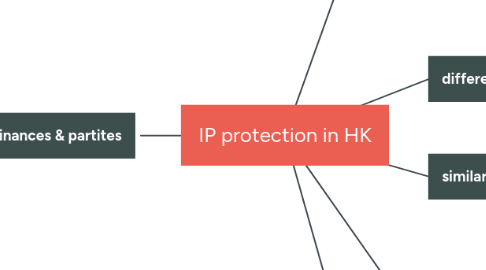
1. definition
1.1. IPD
1.1.1. name commonly given to a group of separate intangible property rights
1.1.2. include
1.1.2.1. trade marks
1.1.2.1.1. trade logos
1.1.2.1.2. trade names
1.1.2.1.3. Trade Marks Ordinance (Cap 559).
1.1.2.2. patents
1.1.2.2.1. pharmaceutical inventions
1.1.2.2.2. mechanical inventions
1.1.2.3. copyright
1.1.2.3.1. films
1.1.2.3.2. music
1.1.2.3.3. artworks
1.1.2.3.4. computer software
1.1.2.3.5. performances
1.1.2.3.6. literature
1.1.2.4. designs
1.1.2.4.1. toys
1.1.2.4.2. jewellery
1.1.2.4.3. fabric pattern
1.1.2.5. plant varieties
1.1.2.6. layout design of integrated circuits
2. Ordinances & partites
2.1. Intellectual Property Department
2.1.1. To underline the commitment of IP protection
2.1.2. established in 2 Jul 1990
2.1.3. advising the Secretary for Commerce and Economic Development on policies and legislation
2.1.4. promoting awareness through public education
2.2. Customs & Excise Department
2.2.1. enforcing the criminal aspects of infringement of IPR
2.2.2. investigates complaints
2.2.2.1. infringement of trademarks and copyright
2.2.2.2. false trade descriptions
2.2.3. help rights-owners to enforce their rights through border enforcement measures
2.3. Law & Ordinances
2.3.1. Basic Law
2.3.1.1. Articles 139 & 140
2.3.1.1.1. the Hong Kong SAR should on its own develop appropriate policies and afford legal protection for intellectual property rights
2.3.2. international conventions
2.3.2.1. WTO
2.3.2.1.1. Trade-Related Aspects of Intellectual Property Rights
2.3.2.2. the Paris Convention
2.3.2.3. the Berne Convention for the Protection of Literary and Artistic Works
2.3.2.4. the Universal Copyright Convention
2.3.2.5. the Nice Agreement concerning the International Classification of Goods and Services for the purposes of the Registration of Marks
2.3.2.6. the Phonograms Convention
2.3.2.7. the Patent Cooperation Treaty
2.3.2.8. WIPO
2.3.2.9. the WIPO Copyright Treaty
2.3.2.10. the WIPO Performances and Phonograms Treaty
2.3.3. The Trade Marks Ordinance (Cap 559)
2.3.3.1. Rights
2.3.3.1.1. exclusive right to use the mark
2.3.3.2. Infringement
2.3.3.2.1. Civil action
2.3.3.2.2. Criminal sanction
2.3.4. Patents Ordinance (Cap 514)
2.3.4.1. standard patents
2.3.4.1.1. designated patent offices
2.3.4.1.2. protection of up to 20 years
2.3.4.2. short-term patents
2.3.4.2.1. protection of up to eight years
2.3.4.2.2. subject to renewal
2.3.4.2.3. made directly to the Hong Kong SAR Patents Registry
2.3.5. The Copyright Ordinance (Cap 528)
2.3.5.1. last for the
2.3.5.1.1. remainder of the life of the creator of the work plus 50 years after the creator dies
2.3.5.1.2. 25 years or 50 years after the work is made, released or published
2.3.6. Registered Designs Ordinance (Cap 522)
3. differences
3.1. IPR in HK / Mainland
3.1.1. IRP registered in HK are not protected in the Mainland vice versa
3.1.2. proprietors must register in each region separately
4. similarities
4.1. Patent Cooperation Treaty
4.1.1. applicant who has designated mainland patent application
4.1.2. can elect to have considered in Hong Kong
5. advantages
5.1. helps creators to protect their creativity
5.2. Benefits the economy
5.3. Promotes innovation
5.4. Helps firms monetize their innovations and grow
5.5. Benefits consumers and society
5.5.1. protect consumers from counterfeit and pirated products
5.5.2. IPR encourages competition
6. Limitations / Disadvantage
6.1. slowing down innovation and progress
6.2. Trade Mark
6.2.1. does not entitle you to the related internet domain names
6.2.2. similar but not identical trademarks infringe upon your business
6.3. Copyrights
6.3.1. Does not protect ideas
6.3.2. only the way in which the idea is expressed To be effective it must be enforced
6.3.3. owners' responsibility for legally asserting copyright if you feel it is infringed
6.4. Patent
6.4.1. Takes time and money to establish a patent
6.4.2. have to be researched to ensure there are no existing patents of a similar nature
6.5. Design
6.5.1. concern how a product works
